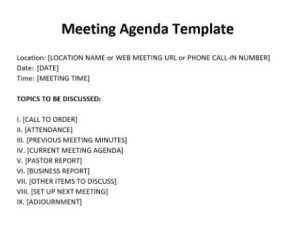How Do You Set a Church Meeting Agenda?
Creating an effective agenda for a church meeting is a critical process that guides the discussion, ensures important topics are covered, and maximizes the productivity of the time spent together. Setting an agenda for a church meeting, particularly for an annual church business meeting, involves understanding the church's needs, anticipating member concerns, and strategically planning discussion points.

Start with a Purpose
The first step in crafting an agenda is to define the purpose of the meeting. What are the main goals? Are there specific issues that need resolution? For instance, if the purpose is to plan the annual budget, then the agenda should revolve around financial discussions. It's crucial to establish these objectives early to keep the meeting focused.
Gather Input from Key Stakeholders
Before finalizing the agenda, reach out to church leaders and active members for their input. This might include the pastor, financial officers, and heads of various ministries. Ask them what topics they believe should be addressed, and what information they can provide. This collaborative approach not only enriches the agenda but also ensures broader representation and engagement during the meeting.
Prioritize Agenda Items
Once you have a list of potential topics, prioritize them based on their importance and urgency. Start the meeting with the most critical issues. This prioritization ensures that if time runs out, the most pressing matters have been addressed. For example, if there is a pressing need to address a recent drop in donations, this should be near the top of the agenda.
Allocate Time Wisely
For each item on the agenda, allocate a realistic amount of time. This helps to manage the meeting duration and keeps discussions on track. Time allocation should reflect the complexity and importance of each topic. For instance, a discussion on the annual budget might need 30 minutes, while a new outreach program proposal might need 15 minutes.
Structure the Agenda for Flow
An effective agenda should have a logical flow. Start with an opening prayer or devotional to set the spiritual tone for the meeting. Follow this with administrative necessities like approving the minutes of the last meeting. Then move into new business and strategic discussions. End with a closing section where future meeting dates can be set, and a final prayer to wrap up the session.
Include Flexibility for Discussion
While it’s important to keep the meeting focused, also allow some flexibility for unexpected discussions or deeper exploration of certain topics. This can be facilitated by including a "new concerns" or "open floor" section towards the end of the meeting, allowing members to bring up issues not initially on the agenda.
Prepare and Distribute the Agenda Early
Distribute the agenda several days before the meeting so that all participants can prepare. Include relevant documents or data that will be discussed. For example, if the annual budget is on the agenda, include a copy of the proposed budget for review.
Review and Revise as Needed
Finally, be prepared to adjust the agenda based on feedback received after it's distributed. This might include adding new items or rearranging existing ones based on what members or leaders see as priorities.
Setting an agenda for the Annual Church Business Meeting is not just about filling time slots—it's about ensuring that the meeting achieves its objectives, addresses the needs of the congregation, and fosters an environment of transparency and collaboration.
